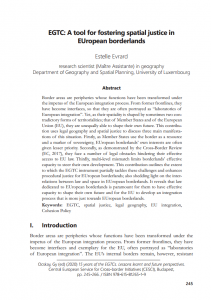European perspective
literature

Information
Author
Estelle Evrard
Year of publication
2020
Language
English (EN)
Download
Share
EGTC: A tool for fostering spatial justice in EUropean borderlands
Abstract
Border areas are peripheries whose functions have been transformed under the impetus of the European integration process. From former frontlines, they have become interfaces, so that they are often portrayed as “laboratories of European integration”. Yet, as their spatiality is shaped by sometimes two contradictory forms of territorialities; that of Member States and of the European Union (EU), they are unequally able to shape their own future. This contribution uses legal geography and spatial justice to discuss three main manifestations of this situation.
Firstly, as Member States use the border as a resource and a marker of sovereignty, EUropean borderlands’ own interests are often given lesser priority. Secondly, as demonstrated by the Cross-Border Review (EC, 2017), they face a number of legal obstacles hindering their effective access to EU law. Thirdly, multi-level mismatch limits borderlands’ effective capacity to steer their own development.
This contribution outlines the extent to which the EGTC instrument partially tackles these challenges and enhances procedural justice for EUropean borderlands; also shedding light on the interrelations between law and space in EUropean borderlands. It reveals that law dedicated to EUropean borderlands is paramount for them to have effective capacity to shape their own future and for the EU to develop an integration process that is more just towards EUropean borderlands.